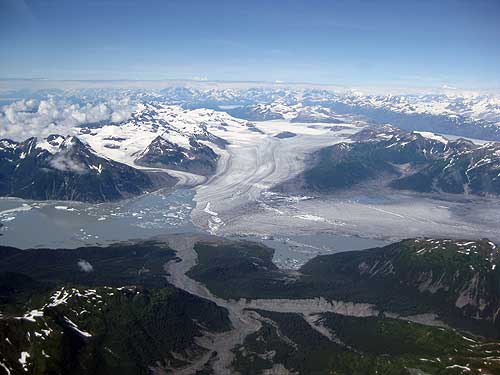
Study of a dying glacier
August 03, 2011
Barbara Truessel has been on deathwatch for this interesting glacier for the past few years. The graduate student at the University of Alaska Fairbanks’ Geophysical Institute has witnessed Yakutat’s fade in the short time it takes to earn a college degree.
Glaciologists say Yakutat Glacier is melting so fast that a few of its lobes will separate from the main ice mass, maybe within a year.
Truessel and her advisor, Martin Truffer, along with glaciologists Chris Larsen and Roman Motyka, recently witnessed the fragmenting of the glacier’s massive tongue, which coats part of Harlequin Lake. “The breakup of the floating tongue started last year,” Truessel said. “Huge tabular icebergs were floating away from the glacier. We were just lucky to be there to see that.” The glaciologists say the glacier is melting so fast that a few of its lobes will separate from the main ice mass, maybe within a year. Truffer said Yakutat, one of the fastest changing bodies of ice in Alaska, would soon become at least three glaciers. Though most other glaciers in Alaska are losing ice fast, Yakutat is unique for a few reasons. One is that it calves into a lake that showed up in about 1850, which, at 1,000 feet deep in places, is “pretty special,” Truessel said. Another is the glacier’s low elevation. The high point of the icefield that feeds Yakutat is about 2,000 feet above sea level, lower than Flattop Mountain near Anchorage and even Ester Dome near Fairbanks (neither of which have glaciers). The ice of Yakutat Glacier formed during a colder period of Earth’s existence. Without a return to those conditions, things don’t look good for Yakutat Glacier. “This glacier is going away,” said Truffer.” It’s not keeping any snow.” As Yakutat shrinks, it exports an impressive amount of fresh water into the ocean through Harlequin Lake and the Dangerous River, which flows into the Gulf of Alaska. Truessel estimates that Yakutat Glacier each year adds as much meltwater to the ocean as the Tanana River dumps into the Yukon in 35 days. Each year, Yakutat Glacier’s meltwater equals six days of the Yukon’s discharge into the Bering Sea. As part of her doctorate, Truessel, who is from Switzerland, is trying to use computer models to determine the date when Yakutat Glacier will disappear. Since 1903, the glacier has receded more than eight miles from where its tongue once pointed defiantly at the Gulf of Alaska. “When it goes, the entire glacier will become a lake,” Truffer said.
This column is provided as a public service by the Geophysical Institute, University of Alaska Fairbanks, in cooperation with the UAF research community.
E-mail your news &
photos to editor@sitnews.us
|
||
